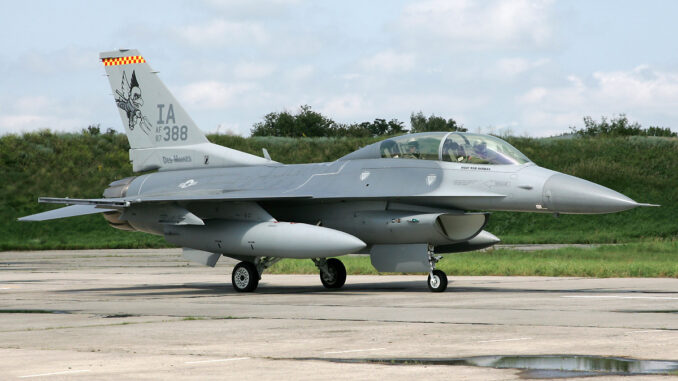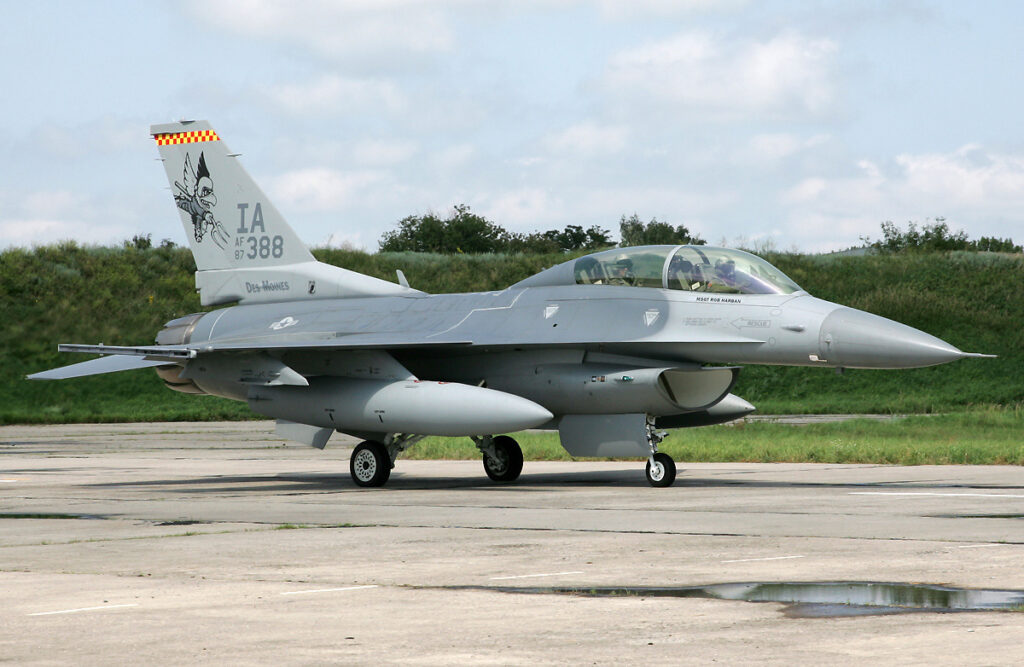
Technical analysis of the military and symbolic effects of the F-16s in Ukraine, their integration into the air defence system and their strategic significance.
The arrival of the F-16s in Ukraine marks a major step forward in the conflict with Russia. These aircraft, supplied by several European countries, will strengthen Ukraine’s defensive and offensive capabilities, while symbolising the West’s continued commitment to Kiev. Beyond their military power, these aircraft represent a crucial moral and strategic change, confirming Ukraine’s integration into Western defence standards.
F-16s in Ukraine: an essential military reinforcement
Ukraine’s acquisition of F-16s, recently confirmed by President Volodymyr Zelenskyy, represents a significant step forward in the war against Russia. These fighter jets, manufactured in the United States, are equipped with capabilities that will considerably improve Ukrainian air defence. The 79 aircraft pledged by Belgium, Denmark, Norway and the Netherlands will add to a hitherto limited arsenal of modern air capabilities.
Increased defensive capabilities
The F-16 is a versatile aircraft, designed to excel in aerial combat, missile defence and precision strikes. By integrating these aircraft into their arsenal, the Ukrainian armed forces will have a powerful tool to counter Russian missile strikes and drone incursions, which have been a constant threat since the start of the conflict. With a maximum speed of 2,414 km/h and an operational ceiling of 15,000 metres, the F-16 is capable of detecting and intercepting long-range aerial targets, thereby increasing the protection of critical infrastructure and civilian populations in Ukraine.
The cost of these aircraft, estimated at around €64 million per unit, also testifies to the importance of this investment in Ukrainian defence. In addition, the F-16s can carry a wide range of munitions, from air-to-air missiles to laser-guided bombs, enabling Ukraine to carry out defence and attack missions with great precision.
Offensive impact: a new dimension in warfare
In addition to their defensive capabilities, the F-16s will enable Ukraine to extend its offensive operations. These aircraft offer the possibility of striking ground targets located on Russian territory, without requiring a ground incursion that would expose Ukrainian troops to considerable risks. This remote strike capability could transform the dynamics of the conflict, enabling Ukraine to target strategic Russian military positions, such as ammunition depots or command centres, with great precision.
However, the acquisition of these aircraft does not mean that Ukraine will immediately gain air superiority. At present, neither Russia nor Ukraine has managed to completely dominate the skies, and the arrival of the F-16s is unlikely to change this situation in the short term. However, the technological advantage that these aircraft give Ukraine could reduce the effectiveness of Russian operations and help to stabilise certain areas of conflict.

Integration challenges: a gradual build-up of power
Incorporating the F-16s into the Ukrainian armed forces will not happen overnight. Several factors complicate this transition. First of all, integrating these aircraft into the Ukrainian air defence system requires complex coordination, including adapting infrastructures and training ground teams to ensure optimum maintenance and operation of the aircraft.
Secondly, although Ukrainian pilots have already undergone intensive training to master the F-16, their numbers remain limited. According to the information available, only a few groups of pilots have been trained so far. This limitation could slow down the effective use of the F-16s in the initial phases of their deployment.
Furthermore, Ukraine will be cautious in its use of these aircraft, seeking to protect them against Russian strikes. Although the F-16s are major assets, they are also priority targets for the enemy. It is therefore likely that their use will initially be restricted while Ukraine develops strategies to maximise their effectiveness while minimising the risks.
The symbolism of the F-16s: a moral and strategic change
The arrival of the F-16s in Ukraine also has a strong symbolic meaning, which should not be underestimated. These aircraft represent concrete support from the West for Ukraine’s fight for independence and sovereignty. The fact that these aircraft have finally been delivered shows that NATO countries, despite international tensions, continue to firmly support Ukraine.
The importance of this symbolic aspect is reflected in the perception of the F-16 as an icon of Western military power. Used by many NATO member countries for almost 50 years, this aircraft is more than just a military tool: it embodies a standard of power and modernity that Ukraine is striving to achieve. For Ukrainian soldiers and civilians alike, the receipt of these aircraft can be seen as tangible proof of the international commitment at their side, boosting morale and resilience in the face of the continuing challenges of conflict.
Modernisation and integration of Ukraine to NATO standards
The arrival of the F-16s is part of a wider process of modernisation of the Ukrainian armed forces, which began in 2014 with the annexation of Crimea by Russia. Since then, Ukraine has embarked on a transformation of its military doctrines, moving away from Soviet standards and adopting Western practices. This process has been supported by numerous partnerships with NATO members, including joint exercises and the supply of modern military equipment.
This modernisation is accompanied by greater interoperability with NATO forces, a crucial aspect of international military cooperation. The integration of F-16s in Ukraine marks a further step in this direction. Ukraine’s ability to operate these aircraft successfully will demonstrate its competence in managing high-tech equipment, strengthening its position as a strategic ally of the West.
Over and above mere military capabilities, the acquisition of the F-16s symbolises Ukraine’s commitment to comply with Western defence standards, a key factor for eventual NATO membership. The transformation of the Ukrainian army, supported by the influx of Western weapons and technology, demonstrates a clear desire to integrate into the Euro-Atlantic security space.
Long-term consequences for war and international relations
The introduction of F-16s in Ukraine will have repercussions beyond the battlefield. In strategic terms, these aircraft could contribute to a rebalancing of forces in the region, by increasing Ukraine’s deterrent capability against future Russian aggression. Moreover, their presence could influence Moscow’s calculations, which could be forced to review its military strategies in the face of a Ukraine increasingly equipped with advanced Western technology.
On the diplomatic front, the integration of the F-16s strengthens the relationship between Ukraine and the West, in particular with the United States and the European countries that supplied the aircraft. This increased cooperation could pave the way for new partnerships, both in the military sphere and in other strategic sectors. It could also speed up the process of Ukraine joining NATO, although this remains a politically sensitive issue.
War Wings Daily is an independant magazine.